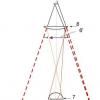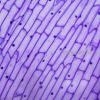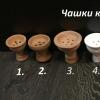page 1

page 2

page 3

page 4

page 5
INTERSTATE STANDARD
Date of introduction 01.01.74
This International Standard applies to drinking water and specifies a colorimetric method for the determination of polyphosphates.
The method is based on the hydrolysis of polyphosphates in an acidic medium, in which they turn into dissolved orthophosphates, which are determined by the colorimetric method in the form of a blue-colored phosphomolybdenum complex. In a separate sample, orthophosphates, which were originally in the water, are determined, the content of which is subtracted from the result obtained in the determination of polyphosphates. The sensitivity of the method is - 0.01 mg/dm 3 .
1. SAMPLING METHODS
1.2. The volume of the water sample to determine the content of polyphosphates must be at least 500 cm 3 .
1.3. Water samples taken in well-leached flasks with ground stoppers.
1.4. If the analysis on the day of sampling is not performed, the water is preserved by adding 2 - 4 cm 3 of chloroform per 1 dm 3 of water.
* On the territory of the Russian Federation, GOST R 51232-98 applies.
** On the territory of the Russian Federation, GOST R 51593-2000 applies.
2. EQUIPMENT, MATERIALS, REAGENTS
Photoelectric colorimeter, cuvettes with a working layer thickness of 2 - 3 cm.
Thermostat with temperature controller.
Electric hob.
Paper filter (blue tape).
Laboratory glassware according to GOST 1770, GOST 29227 and GOST 29169 with a capacity of: volumetric flasks 50, 100 and 1000 cm 3, volumetric pipettes 1 - 2 cm 3 with divisions of 0.01 cm 3, 5 - 10 cm 3 with divisions of 0.1 cm 3; pipettes measured 5, 10, 20, 50 and 100 cm 3 without divisions.
Glass laboratory glasses in accordance with GOST 25336.
Ammonium molybdate according to GOST 3765.
Potassium phosphate monosubstituted according to GOST 4198.
Tin dichloride according to TU 6-09-5384.
Sulfamic acid.
All utensils should be treated with hot hydrochloric acid and thoroughly rinsed with distilled water.
All reagents must be of analytical grade.
3. PREPARATION FOR ANALYSIS
3.1 . Preparation of the basic standard solution of monobasic potassium phosphate.
0.7165 g KH 2 PO 4, x. hours, previously dried in a thermostat for 2 hours at 105 ° C, dissolved in a volumetric flask with a capacity of 1000 cm 3 with distilled water and bring the volume of the solution to the mark, add 2 cm 3 of chloroform. 1 cm 3 solution contains 0.5 mg
3.2 . Preparation of the first working standard solution of one-substituted potassium phosphate.
10 cm 3 of the stock solution is adjusted to 1 dm 3 with distilled water, 1 cm 3 of the solution contains 0.005 mg .
3.3 . Preparation of the second working standard solution of one-substituted potassium phosphate.
50 cm 3 I of the working solution is adjusted to 250 cm 3 with distilled water. 1 cm 3 solution contains 0.001 mg.
A freshly prepared solution must be used.
3.4 . Preparation of ammonium molybdate (reagent I, acid solution)
25 g (NH 4) 6 Mo 7 O 24 4H 2 O are dissolved in 600 cm 3 of distilled water. To this solution, carefully, while cooling, add 337 cm 3 of concentrated 98% sulfuric acid. After cooling, the solution is adjusted with distilled water to 1 dm 3 . The solution is stored in a dark glass bottle with a ground stopper. The reagent can be used 48 hours after preparation.
3.5 . Preparation of ammonium molybdate (reagent II, slightly acidic solution)
10 g (NH 4) 6 Mo 7 O 24 4H 2 O are dissolved in 400 cm 3 of distilled water and 7 cm 3 of concentrated 98% sulfuric acid are added. The solution is stored in a polyethylene bottle in a dark place. Stable for about 3 months. The reagent can be used 48 hours after preparation.
3.6 . Preparation of a 37% sulfuric acid solution
337 cm 3 of concentrated 98% sulfuric acid are carefully mixed, pouring in small portions to 600 cm 3 of distilled water. After cooling, the solution is adjusted with distilled water to 1 dm 3 .
3.7 . Preparation of the basic solution of stannous chloride
1.95 g of crystalline unweathered SnCl 2 2H 2 O is dissolved in 50 cm 3 of 13.6% hydrochloric acid (18.4 cm 3 of 37% HCl, not containing arsenic, is adjusted to 50 cm 3 with distilled water). The suspension is thoroughly mixed, stored in a bottle covered inside with a layer of paraffin. The suspension is well mixed before use. The suspension can be applied directly after preparation.
3.8 . Preparation of a working solution of stannous chloride
2.5 cm 3 of the stock solution (suspension) is adjusted with distilled water to 10 cm 3 .
A freshly prepared solution must be used. The solution is stable for about 4 hours.
4. CONDUCTING THE ANALYSIS
4.1. The determination is hindered by iron at a concentration exceeding 1 mg/dm 3 , soluble silicates over 25 mg/dm 3 , nitrites. The influence of iron and silicates is eliminated by appropriate dilution of the test water. The influence of nitrites at concentrations up to 25 mg/dm 3 is eliminated by adding 0.1 g of sulfamic acid NH 2 SO 2 OH to the sample, which is added before ammonium molybdate is added to the sample.
4.2 . Determination of orthophosphates
To 50 cm 3 of the investigated water (without dilution, no more than 0.4 mg / dm 3 can be determined), filtered through a dense “blue tape” paper filter, the same reagents are added and in the same sequence as in the reference solutions. The optical density of the solution is determined by an electrophotocolorimeter. The concentration of orthophosphates is set according to the calibration curve.
4.3 . Determination of polyphosphates
To 100 cm 3 of the investigated water, filtered through a dense paper filter, or to a smaller volume, brought to 100 cm 3 with distilled water, add 2 cm 3 of a 37% sulfuric acid solution and boil for 30 minutes. The volume of the investigated water support by adding distilled water in the range of 50 - 90 cm 3 . After cooling the solution, transfer it to a volumetric flask with a capacity of 100 cm 3 and bring the volume to the mark with distilled water. Add 1 cm 3 of a weakly acid solution of a molybdate solution (reagent II), mix, and after 5 minutes add 0.1 cm 3 of a working solution of stannous chloride, then mix again. After 10 - 15 minutes, the color intensity is measured with an electrophotocolorimeter.
4.4 . Construction of a calibration graph
Pipette 0.0 into volumetric flasks with a capacity of 50 cm 3; 0.5; 1.0; 2.0; 5.0; 10.0; 20.0 cm 3 working standard solution of potassium phosphate (1 cm 3 - 0.001 mg) and dilute the solution to the mark with distilled water. The content of polyphosphates in the sample solutions will be respectively equal to: 0.0; 0.01; 0.02; 0.04; 0.10; 0.20; 0.40 mg in 1 dm 3 of water. Exactly 1 cm 3 of ammonium molybdate (reagent I, acid solution) is added to each flask, mixed, and after 5 minutes, 0.1 cm 3 of a working solution of stannous chloride is added with a micropipette and mixed. The color intensity is measured after 10 - 15 minutes with a photoelectric colorimeter using a red light filter (l = 690 - 720 nm) and cuvettes with a layer thickness of 2 - 3 cm. The optical density of the control sample is subtracted from the obtained optical densities and the results are plotted on a graph.
5. PROCESSING THE RESULTS
Where C- the content of orthophosphates, found on the calibration graph, mg/cm 3 ;
50 - bringing the volume of the investigated water to 50 cm 3 ;
V- the volume of the investigated water taken for determination, cm 3 .
Where WITH 1 - the content of polyphosphates, found on the calibration graph, mg/DM 3 ;
100 - bringing the volume of the investigated water to 100 cm 3 ;
V- the volume of the investigated water taken for determination, cm 3 .
The allowable discrepancy between repeated determinations of polyphosphates is 0.01 mg/dm 3 if their content does not exceed 0.07 mg/dm 3 , with a higher content - 15% rel.
INFORMATION DATA
1. APPROVED AND PUT INTO EFFECT by the Decree of the State Committee of Standards of the Council of Ministers of the USSR of December 28, 1972 No. 2356
2. INTRODUCED FOR THE FIRST TIME
3. REFERENCE REGULATIONS AND TECHNICAL DOCUMENTS
drinking water. Method for determination of Polyphosphate content
Introduction date 01.01.74
This International Standard applies to drinking water and specifies a colorimetric method for the determination of polyphosphates.
The method is based on the hydrolysis of polyphosphates in an acidic medium, in which they turn into dissolved orthophosphates, which are determined by the colorimetric method in the form of a blue-colored phosphomolybdenum complex. In a separate sample, orthophosphates, which were originally in the water, are determined, the content of which is subtracted from the result obtained in the determination of polyphosphates. The sensitivity of the method is - 0.01 mg/dm 3 .
. SAMPLING METHODS
** On the territory of the Russian Federation, GOST R 51593-2000 applies.
2. EQUIPMENT, MATERIALS, REAGENTS
Photoelectric colorimeter, cuvettes with a working layer thickness of 2 - 3 cm.
Thermostat with temperature controller.
Electric hob.
Paper filter (blue tape).
Laboratory glassware according to GOST 1770, GOST 29227 and GOST 29169 with a capacity of: volumetric flasks 50, 100 and 1000 cm 3, volumetric pipettes 1 - 2 cm 3 with divisions of 0.01 cm 3, 5 - 10 cm 3 with divisions of 0.1 cm 3; pipettes measured 5, 10, 20, 50 and 100 cm 3 without divisions.
Glass laboratory glasses in accordance with GOST 25336.
Ammonium molybdate according to GOST 3765.
Potassium phosphate monosubstituted according to GOST 4198.
Tin dichloride according to TU 6-09-5384.
Sulfamic acid.
Distilled water according to GOST 6709.
All utensils should be treated with hot hydrochloric acid and thoroughly rinsed with distilled water.
All reagents must be of analytical grade.
. PREPARATION FOR ANALYSIS
3.1 . Preparation of the basic standard solution of monobasic potassium phosphate.
0 .7165 g KH 2 PO 4 , X. hours, previously dried in a thermostat for 2 hours at 105 ° C, dissolved in a volumetric flask with a capacity of 1000 cm 3 with distilled water and bring the volume of the solution to the mark, add 2 cm 3 of chloroform. 1 cm 3 solution contains 0.5 mg
3.2 . Preparation of the first working standard solution of one-substituted potassium phosphate.
10 cm 3 of the main solution is adjusted to 1 dm 3 with distilled water, 1 cm 3 of the solution contains 0.005 mg.
3.3 . Preparation of the second working standard solution of one-substituted potassium phosphate.
50 cm 3 I of the working solution is adjusted to 250 cm 3 with distilled water. 1 cm 3 solution contains 0.001 mg.
A freshly prepared solution must be used.
3.4 . Preparation of ammonium molybdate (reagent I, acid solution)
25 g (NH 4) 6 Mo 7 O 24 · 4H 2 O is dissolved in 600 cm 3 of distilled water. To this solution, carefully, while cooling, add 337 cm 3 of concentrated 98% sulfuric acid. After cooling, the solution is adjusted with distilled water to 1 dm 3 . The solution is stored in a dark glass bottle with a ground stopper. The reagent can be used 48 hours after preparation.
3.5 . Preparation of ammonium molybdate (reagent II, slightly acidic solution)
10 g (NH 4 ) 6 Mo 7 O 24 4H 2 O is dissolved in 400 cm 3 of distilled water and 7 cm 3 of concentrated 98% sulfuric acid are added. The solution is stored in a polyethylene bottle in a dark place. Stable for about 3 months. The reagent can be used 48 hours after preparation.
3.6 . Preparation of a 37% sulfuric acid solution
337 cm 3 of concentrated 98% sulfuric acid is carefully mixed, pouring in small portions to 600 cm 3 of distilled water. After cooling, the solution is adjusted with distilled water to 1 dm 3 .
3.7 . Preparation of the basic solution of stannous chloride
1 .95 g crystalline unweathered SnCl 2 2H 2 O is dissolved in 50 cm 3 of 13.6% hydrochloric acid (18.4 cm 3 of 37% HCl, not containing arsenic, is adjusted to 50 cm 3 with distilled water). The suspension is thoroughly mixed, stored in a bottle covered inside with a layer of paraffin. The suspension is well mixed before use. The suspension can be applied directly after preparation.
3.8 . Preparation of a working solution of stannous chloride
2 .5 cm 3 of the main solution (suspension) is adjusted with distilled water to 10 cm 3.
A freshly prepared solution must be used. The solution is stable for about 4 hours.
. ANALYSIS
4.1 . The determination is hindered by iron at a concentration exceeding 1 mg/dm 3 , soluble silicates over 25 mg/dm 3 , nitrites. The influence of iron and silicates is eliminated by appropriate dilution of the test water. The effect of nitrites at concentrations up to 25 mg/dm 3 is eliminated by adding 0.1 g of sulfamic acid NH to the sample 2SO2 OH, which is introduced before adding ammonium molybdate to the sample.
4.2 . Determination of orthophosphates
To 50 cm 3 of the investigated water (without dilution, no more than 0.4 mg / dm 3 can be determined), filtered through a thick blue tape filter paper, add the same reagents and in the same sequence as in the reference solutions. The optical density of the solution is determined by an electrophotocolorimeter. The concentration of orthophosphates is set according to the calibration curve.
4.3 . Determination of polyphosphates
To 100 cm 3 of the investigated water, filtered through a dense paper filter, or to a smaller volume, brought to 100 cm 3 with distilled water, add 2 cm 3 of a 37% sulfuric acid solution and boil for 30 minutes. The volume of the investigated water support by adding distilled water in the range of 50 - 90 cm 3 . After cooling the solution, transfer it to a volumetric flask with a capacity of 100 cm 3 and bring the volume to the mark with distilled water. Add 1 cm 3 of a weakly acid solution of a molybdate solution (reagent II), mix, and after 5 minutes add 0.1 cm 3 of a working solution of stannous chloride, then mix again. After 10 - 15 minutes, the color intensity is measured with an electrophotocolorimeter.
4.4 . Construction of a calibration graph
Pipette 0.0 into volumetric flasks with a capacity of 50 cm 3; 0.5; 1.0; 2.0; 5.0; 10.0; 20.0 cm 3 working standard solution of potassium phosphate (1 cm 3 - 0.001 mg) and dilute the solution to the mark with distilled water. The content of polyphosphates in the sample solutions will be respectively equal to: 0.0; 0.01; 0.02; 0.04; 0.10; 0.20; 0.40 mgin 1 dm 3 of water. Exactly 1 cm 3 of ammonium molybdate (reagent I, acid solution) is added to each flask, mixed, and after 5 minutes, 0.1 cm 3 of a working solution of stannous chloride is added with a micropipette and mixed. The color intensity is measured after 10-15 minutes with a photoelectric colorimeter using a red light filter ( l \u003d 690 - 720 nm) and cuvettes with a layer thickness of 2 - 3 cm. From the obtained optical densities, the optical density of the control sample is subtracted and the results are plotted on a graph.
. PROCESSING THE RESULTS
5.1 . The content of inorganic dissolved orthophosphates (X), mg / dm 3, determined by the formula
Where C- the content of orthophosphates, found on the calibration graph, mg/cm 3 ;
50 - bringing the volume of the investigated water to 50 cm 3 ;
V - the volume of the investigated water taken for determination, cm 3 .
5.2 . The content of hydrolyzable polyphosphates (X 1 ), mg / dm 3, determined by the formula
![]()
Where WITH 1 - the content of polyphosphates, found on the calibration graph, mg/DM 3 ;
100 - bringing the volume of the investigated water to 100 cm 3 ;
V - the volume of the investigated water taken for determination, cm 3 .
The allowable discrepancy between repeated determinations of polyphosphates is 0.01 mg/dm 3 if their content does not exceed 0.07 mg/dm 3 , with a higher content - 15% rel.
During the hydrolysis of condensed phosphates (polyphosphates), hydrolysis of organic phosphates also partially occurs. During the decomposition of organic phosphates, polyphosphates are also quantitatively hydrolyzed. For this reason, a total determination of all dissolved phosphates is carried out, the results of which, minus the content of orthophosphates, characterize the total amount of dissolved, condensed and organic phosphates.[ ...]
Definition progress. To 50 ml of the sample filtered on the day of sampling (at the sampling site or in the laboratory) through a No. 1 membrane filter or through a dense paper filter (or to a smaller sample volume, but diluted to 50 ml with distilled water), add 2 ml of the mixed solution and through for a short time - 0.5 ml of ascorbic acid solution (as mentioned above, in the presence of some interfering substances, the reagents are poured in the reverse order). The mixture is stirred. At the same time, a blank determination is made with 50 ml of distilled water. If the analyzed sample contains polyphosphates or organic phosphorus compounds, the optical density of the solution is measured in the time interval from 5 to 15 minutes. If there are no easily hydrolyzable compounds, this period of time can be extended to 60 min.[ ...]
The method is based on the hydrolysis of polyphosphates in an acidic medium, in which they turn into dissolved orthophosphates, which are determined by the colorimetric method as a blue-colored phosphorus-molybdenum complex. In a separate sample, orthophosphates, which were originally in the water, are determined, the content of which is subtracted from the result obtained in the determination of polyphosphates. The sensitivity of the method is 0.01 mg/dm3.[ ...]
In the previously used method, the determination of orthophosphates was carried out by the molybdate method using ascorbic acid as a reducing agent. The recovery process in this case occurs when heated for 15-20 minutes, which leads to the hydrolysis of polyphosphates and phosphorus-containing organic compounds.[ ...]
The use of ultraviolet irradiation of natural sea water leads to the complete decomposition of organically bound phosphorus and at the same time does not affect polyphosphates, which are represented by inorganic and organic forms. This technique is recommended for the determination of organic phosphorus in sea water. Under the aforementioned irradiation of natural (i.e., without preliminary acidification and heating) samples of land surface waters, the results of determining the formed orthophosphates turned out to be underestimated. In fresh waters, the determination of total phosphorus by ultraviolet irradiation is possible if it is carried out in a slightly acidic environment.[ ...]
The essence of the method. Acid hydrolysis of polyphosphates and esters of phosphoric acid is carried out, as a result of which these compounds are converted into soluble inorganic orthophosphates, the latter are then determined by adding molybdate and ascorbic acid. The result of the determination also includes the content of those orthophosphates that were originally in the sample, it must be subtracted from the result.[ ...]
The purpose of this work is to determine the phosphorus reserve of plankton populations by the degree of accumulation of polyphosphates in seston and the increase in the content of total phosphorus in it with the addition of PO4-. Determination of polyphosphates was carried out by acid hydrolysis of these compounds to orthophosphates at 100°C. The method is not specific; results may be affected by partially hydrolyzable labile organic compounds. But, since the response of organisms to the addition of PO “p mainly affects the phase of formation of labile polyphosphates, it can be assumed that the results obtained by this method after daily exposure will reflect changes in the content of this particular fraction.
The method is based on the hydrolysis of polyphosphates in an acidic medium. There is a transition of polyphosphates into dissolved orthophosphates, which are determined by a colorimetric method in the form of a phosphorus-libdenum complex, colored blue. In a separate sample, orthophosphates initially contained in water are detected, the amount of which is subtracted from the result obtained in the determination of phosphates. Water samples are taken into well-leached flasks with ground stoppers.
The preparation of the analysis consists of the following steps:
1) preparation of the basic standard solution of monosubstituted potassium phosphate (0.7165 g of the drug, previously dried in
thermostat for 2 hours at 105 0 C, dissolved in a 1 liter volumetric flask
distilled water and dilute to the mark by adding 2 ml of chloroform) -
1 ml of solution contains 0.5 mg of phosphate ion;
2) preparation of the first working standard composition of monosubstituted potassium phosphate - 10 ml of the stock solution is brought to 1 liter with distilled water, 1 ml of the solution contains 0.005 mg of phosphate ion;
3) preparation of the second working standard composition of monosubstituted potassium phosphate - 50 ml of the first solution is adjusted to 250 ml
distilled water. 1 ml of solution contains 0.001 mg of phosphate ion;
use a fresh solution;
4) preparation of ammonium molybdate (reagent 1, acidic solution) - 25 g of the drug is dissolved in 600 ml of distilled water. To that
solution, carefully cooling, add 337 ml of concentrated 98%
sulfuric acid. Then dilute with distilled water to 1 litre. Solution
stored in a dark glass bottle with a ground stopper, use it
48 hours after preparation;
5) preparation of ammonium molybdate (reagent 2, slightly acidic
solution) - 10 g of the drug is dissolved in 400 ml of distilled water.
To this solution, while gently cooling, add 7 ml of concentrated 98% sulfuric acid. Then dilute with distilled water to 1 litre. The solution is stored in a dark glass bottle with a ground stopper, it is used 48 hours after preparation;
6) preparation of a 37% solution of sulfuric acid - 33.7 ml of concentrated 98% sulfuric acid are carefully mixed, pouring not
in large portions to 60 ml of distilled water. After cooling
the solution is adjusted to 100 ml;
7) preparation of a basic solution of tin dioxide - 1.95 g of a crystalline, not weathered preparation is dissolved in 50 ml of 13.6% hydrochloric acid (18.4 ml of 37% arsenic-free acid is adjusted to
50 ml distilled water). The suspension is thoroughly mixed, used immediately after receipt or stored in a bottle covered inside
a layer of paraffin;
8) preparation of a working solution of tin dichloride - 2.5 ml of the stock solution is adjusted with distilled water to 10 ml, apply
fresh solution, its stability is about 4 hours.
The determination of polyphosphates interfere with iron at a concentration of more than 1 mg / l, soluble silicates - more than 25 mg / l, nitrites. The influence of iron is eliminated by appropriate dilution with the test water. The influence of nitrites at concentrations up to 25 mg/l is eliminated by adding 0.1 g of sulfamic acid to the sample (it is added to ammonium molybdate).
Method for determining orthophosphates. In 50 ml of the test water, passed through a dense paper filter (“blue ribbon”), the same reagents are added as in the reference solutions. The optical density of the solution is determined using FEC, and the concentration of orthophosphates is set according to the calibration curve.
Method for the determination of polyphosphates. To 100 ml of the test water passed through a dense paper filter, or to a smaller volume brought to 10 ml with distilled water, add 2 ml of a 37% sulfuric acid solution and boil for 30 minutes. The volume of the investigated water is maintained by adding 50-90 ml of distilled water. After cooling, the solution is transferred to a 100 ml volumetric flask and the volume is adjusted to the mark. Add 1 ml of a weakly acidic molybdate solution (reagent 2); mix and after 5 minutes add 0.1 ml of a working solution of tin dichloride and mix again. After 10-15 minutes, the color intensity is measured on the FEC.
Construction of a calibration graph: pipette 0 into 50 ml volumetric flasks; 0.5; 1; 2; 5, 10 and 20 ml of a working standard solution of potassium phosphate (1 mg - 0.001 mg of phosphate ion) and bring the volume to its mark with distilled water.
The content of polyphosphates in the sample solutions will be respectively: 0; 0.01; 0.02; 0.04; 0.1; 0.2 and 0.4 mg of phosphate ion in 1 liter of water. Exactly 1 ml of ammonium molybdate (reagent 1) is added to each flask, and after 5 minutes 0.1 ml of the working solution of stannous chloride is added with a pipette and mixed again. The color intensity is measured after 10-15 minutes on FEC, with a red light filter and cuvettes with a layer thickness of 2-3 cm.
The optical density of the control sample is subtracted from the obtained values of optical densities and the results are plotted on a graph.














